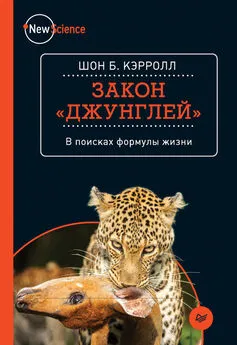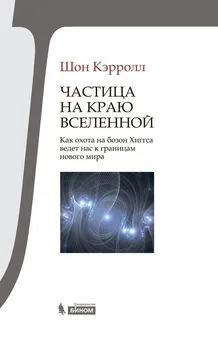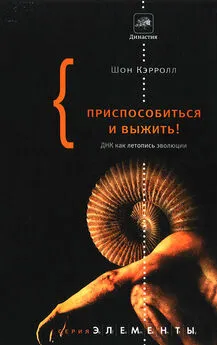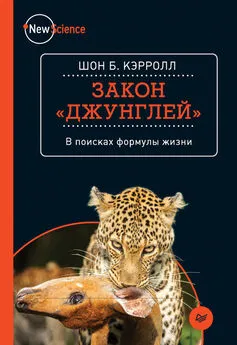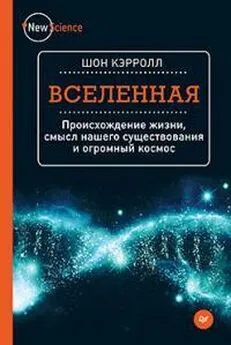Шон Кэрролл - Закон «джунглей»
- Название:Закон «джунглей»
- Автор:
- Жанр:
- Издательство:ИздательствоПитер046ebc0b-b024-102a-94d5-07de47c81719
- Год:2016
- Город:Санкт-Петербург
- ISBN:978-5-496-02391-7
- Рейтинг:
- Избранное:Добавить в избранное
-
Отзывы:
-
Ваша оценка:
Шон Кэрролл - Закон «джунглей» краткое содержание
Как работает жизнь? Как природа знает, сколько зебр и львов должно жить в саванне или сколько рыб должно плавать в океане? Откуда наш организм знает, сколько эритроцитов должно быть в крови? Шон Кэрролл – американский биолог, ведущий специалист в области эво-дево – рассказывает нам невероятно интересную историю открытий. Сокровенные тайны природы – законы, которые управляют количеством клеток в наших телах, животных и растений в дикой природе. Самое удивительное в этих правилах то, что они похожи и подчиняются одной логике – логике жизни. Кэрролл рассказывает о том, как знания законов функционирования человеческого тела стимулировали появление лекарств и подводит нас к мысли, что настало время использовать законы «джунглей», чтобы исцелить нашу больную планету.
Смелый и вдохновляющий труд одного из самых знаменитых биологов и одаренных популяризаторов науки рассказывает про законы жизни во всех формах, проявлениях и масштабах. Прочитайте эту книгу, и ваш взгляд на мир изменится.
Закон «джунглей» - читать онлайн бесплатно ознакомительный отрывок
Интервал:
Закладка:
Benison, S., A. C. Barger, and E. L. Wolfe (1987) Walter B. Cannon: The Life and Times of a Young Scientist . Cambridge, Massachusetts: Harvard University Press.
Berger, K. M., E. M. Gese, and J. Berger (2008) “Indirect Effects and Traditional Trophic Cascades: A Test Involving Wolves, Coyotes, and Pronghorn.” Ecology 89(3): 818–828.
Bernes, C., S. R. Carpenter, A. Gardmark, P. Larsson, et al. (2015). “What Is the Influence of a Reduction of Planktivorous and Benthivorous Fish on Water Quality in Temperate Eutrophic Lakes? A Systematic Review.” Environmental Evidence 4:7: 1–28.
Beschta, R. L. (2005) “Reduced Cottonwood Recruitment Following Extirpation of Wolves in Yellowstone’s Northern Range.” Ecology 86: 391–403.
Bianconi, E., A. Piovesan, F. Facchin, A. Beraudi, et al. (2013) “An Estimation of the Number of Cells in the Human Body.” Annals of Human Biology Early Online 40: 1–11.
Biggs, P. M. (2010) “Walter Plowright. 20 July 1923–20 February 2010.” Biographical Memoirs of Fellows of the Royal Society 56: 341–358.
Bilheimer, D. W., S. M. Grundy, M. S. Brown, and J. L. Goldstein. (1983) “Mevinolin and Colestipol Stimulate Receptor-Mediated Clearance of Low Density Lipoprotein from Plasma in Familial Hypercholesterolemia Heterozygotes.” Proceedings of the National Academy of Sciences USA 80(13): 4124–4128.
Binney, G. (1926) With Seaplane and Sledge in the Arctic . New York: George H. Doran.
Bishop, J. M. (2003) How to Win the Nobel Prize: An Unexpected Life in Science . London: Harvard University Press.
Brashares, J. S., L. R. Prugh, C. J. Stoner, and C. W. Epps (2010) “Ecological and Conservation Implications of Mesopredator Release.” In J. Terborgh and J. A. Estes (eds.), Trophic Cascades: Predators, Prey, and the Changing Dynamics of Nature . Washington, DC: Island Press: 221–240.
Brock, T. D. (1985) A Eutrophic Lake: Lake Mendota, Wisconsin . New York: Springer-Verlag.
Brown, M. S., and J. L. Goldstein (1975) “Regulation of the Activity of the Low Density Lipoprotein Receptor in Human Fibroblasts.” Cell 6: 307–316.
– – (1981) “Lowering Plasma Cholesterol by Raising LDL Receptors.” New England Journal of Medicine 305(9): 515–517.
– – (1993) “A Receptor-Mediated Pathway for Cholesterol Homeostasis.” In T. Frängsmyr and J. Lindsten (eds.), Nobel Lectures, Physiology of Medicine 1981–1990 . Singapore: World Scientific: 284–324. Available at nobelprize.org.
– – (2004) “A Tribute to Akira Endo, Discoverer of a ‘Penicillin’ for Cholesterol.” Atherosclerosis Supplements 5: 13–16.
Brown, M. S., S. E. Dana, and J. L. Goldstein (1973) “Regulation of 3-Hydroxy-3-Methylglutaryl Coenzyme A Reductase Activity in Human Fibroblasts by Lipoproteins.” Proceedings of the National Academy of Sciences USA 70(7): 2162–2166.
– – (1974) “Regulation of 3– Hydroxy– 3– Methylglutaryl Coenzyme A Reductase Activity in Cultured Human Fibroblasts.” Journal of Biological Chemistry 249: 789–796.
Brown, M. S., J. R. Faust, J. L. Goldstein, I. Kaneko, and A. Endo (1978) “Induction of 3-Hydroxy-3-Methylglutaryl Coenzyme A Reductase Activity in Human Fibroblasts Incubated with Compactin (ML– 236B), a Competitive Inhibitor of the Reductase.” Journal of Biological Chemistry 253: 1121–1128.
Cannon, W. B. (1873–1945) Walter Bradford Cannon papers, 1873–1945, 1972–1974 (inclusive), 1881–1945 (bulk). H MS c40. Harvard Medical Library, Francis A. Countway Library of Medicine, Boston.
– – (1898) “The Movements of the Stomach Studied by Means of the Röntgen Rays.” American Journal of Physiology 1: 359–382.
– – (1909) “The Influence of Emotional States on the Functions of the Alimentary Canal.” American Journal of Medical Sciences 137: 480–487.
– – (1911a) The Mechanical Factors of Digestion . London: Edward Arnold.
– – (1911b) “The Stimulation of Adrenal Secretion by Emotional Excitement.” Proceedings of the American Philosophical Society 50(199): 226–227.
– – (1914) “The Emergency Function of the Adrenal Medulla in Pain and the Major Emotions.” American Journal of Physiology 33: 356–372.
– – (1927) Bodily Changes in Pain, Hunger, Fear and Rage: An Account of Recent Researches into the Function of Emotional Excitement . New York and London: D. Appleton and Company.
– – (1928) “Reasons for Optimism in the Care of the Sick.” New England Journal of Medicine 199(13): 593–597.
– – (1929) “Organization for Physiological Homeostasis.” Physiological Reviews 9(3): 399–431.
– – (1963) The Wisdom of the Body . Revised and enlarged ed. New York: W. W. Norton & Company.
– – (1972) The Life and Contributions of Walter Bradford Cannon . Edited by C. McC. Brooks, K. Koizumi, and J. O. Pinkston. New York: Downstate Medical Center, State University of New York.
Cannon, W. B., and D. de la Paz (1911) “Emotional Stimulation of Adrenal Secretion.” American Journal of Physiology 28: 64–70.
Carpenter, S. R., J. F. Kitchell, and J. R. Hodgson (1985) “Cascading Trophic Interactions and Lake Productivity.” BioScience 35(10): 634–639.
Carpenter, S. R., J. F. Kitchell, J. R. Hodgson, P. A. Cochran, et al. (1987) “Regulation of Lake Primary Productivity by Food Web Structure.” Ecology 68(6): 1863–1876.
Carroll, S. B. (2013) “Brave Genius: a Scientist, a Philosopher, and Their Daring Adventures from the French Resistance to the Nobel Prize.” New York: Crown.
Chandler, R. F. Jr. (1992) An Adventure in Applied Science: A History of the International Rice Research Institute . Los Baños, Laguna, Philippines: International Rice Research Institute.
Cumming, D. H. M, C. Mackie, S. Magane, and R. D. Taylor (1994) Aerial Census of Large Herbivores in the Gorongosa National Park and the Marromeu Area of the Zambezi Delta in Mozambique . Unpublished report, IUCN ROSA, Harare, 10 pp., cited in K. M. Dunham (2004) “Aerial Survey of Large Herbivores in Gorongosa National Park, Mozambique: 2004.” A Report for The Gregory C. Carr Foundation . http://www carrfoundation.org.
Darwin, C. (1872) The Origin of Species by Means of Natural Selection, or The Preservation of Favoured Races in the Struggle for Life . Sixth ed. London: John Murray.
Debré, P. (1996) Jacques Monod . Paris: Flammarion.
De Klein, A., A. G. van Kessel, G. Grosveld, C. R. Bartram, et al. (1982) “A Cellular Oncogene Is Translocated to the Philadelphia Chromosome in Chronic Myelocytic Leukaemia.” Nature 300: 765–767.
Di Fiore, R., A. D’Anneo, G. Tesoriere, and R. Vento (2013) “RB1 in Cancer: Different Mechanisms of RB1 Inactivation and Alterations of pRb Pathway in Tumorigenesis.” Journal of Cellular Physiology 228:1676–1687.
Drach, P., and J. Monod (1935) “Rapport préliminaire sur les observations d’histoire naturelle faites pendant la camoagne de la ‘Pourquios-Pas?’ au Groenland.” Annales Hydrographiques 2: 3–11.
Druker, B. J. (2003) “David A. Karnofsky Award Lecture. Imatinib as a Paradigm of Targeted Therapies.” Journal of Clinical Oncology 21(23 suppl): 239–245.
– – (2014) “Janet Rowley (1925–2013).” Nature 505: 484.
Dublin, H. T., and I. Douglas-Hamilton (1987) “Status and Trends of Elephants in the Serengeti-Mara Ecosystem.” African Journal of Ecology 25: 19–33.
Dubos, R. J. (1965) Man Adapting . New Haven, Connecticut: Yale University Press.
Duggins, D. O. (1980) “Kelp Beds and Sea Otters: An Experimental Approach.” Ecology 61(3): 447–453.
Dulvy, N. K., S. L. Fowler, J. A. Musick, R. D. Cavanagh, et al. (2014). “Extinction Risk and Conservation of the World’s Sharks and Rays.” eLife 3: e00590.
Dunham, K. M. (2004) “Aerial Survey of Large Herbivores in Gorongosa National Park, Mozambique: 2004.” Report for the Gregory C. Carr Foundation . http://www.carrfoundation.org.
Dutton, P. (1994) “A Dream Becomes a Nightmare.” African Wildlife 48(6): 6–14.
Dyck, V. A., and B. Thomas (1979) “The Brown Planthopper Problem.” In Brown Planthopper: Threat to Rice Production in Asia . Los Baños, Philippines: International Rice Research Institute: 3–17.
Eisenberg, C. (2010) The Wolf’s Tooth: Keystone Predators, Trophic Cascades, and Biodiversity . Washington, DC: Island Press.
Eisenberg, C., S. T. Seager, and D. E. Hibbs (2013) “Wolf, Elk, and Aspen Food Web Relationships: Context and Complexity.” Forest Ecology and Management 299: 70–80.
Elton, C. S. (1924) “Periodic Fluctuations in the Numbers of Animals: Their Causes and Effects.” British Journal of Experimental Biology 2: 119–163.
– – (1927) Animal Ecology . New York: Macmillan.
– – (1983) “The Oxford University Expedition to Spitsbergen in 1921: An Account, Done in 1978–1983.” Norsk Polarinstitutt Bibliotek, Norsk Polarinstitutt, Oslo. http://brage.bibsys.no/xmlui/handle/11250/218913.
Elton, C. S., and M. Nicholson (1942) “The Ten-Year Cycle in Numbers of the Lynx in Canada.” Journal of Animal Ecology 11(2): 215–244.
Endo, A. (1992) “The Discovery and Development of HMG-CoA Reductase Inhibitors.” Journal of Lipid Research 33: 1569–1582.
– – (2004) “The Origin of the Statins.” Atherosclerosis Supplements 5: 125–130.
– – (2008) “A Gift From Nature: The Birth of the Statins.” Nature Medicine 14(10): 1050–1025.
– – (2010) “A Historical Perspective on the Discovery of Statins.” Proceedings of the Japan Academy, Series B 86: 484–498.
Estes, J. A., and J. F. Palmisano (1974) “Sea Otters: Their Role in Structuring Nearshore Communities.” Science 185: 1058–1060.
Estes, J. A., C. H. Peterson, and R. S. Steneck (2010) “Some Effects of Apex Predators in Higher-Latitude Coastal Oceans.” In J. Terborgh and J. A. Estes (eds.), Trophic Cascades: Predators, Prey, and the Changing Dynamics of Nature . Washington, DC: Island Press: 37–53.
Estes, J. A., M. T. Tinker, T. M. Williams, and D. F. Doak (1998) “Killer Whale Predation on Sea Otters Linking Oceanic and Nearshore Ecosystems.” Science 282: 473–476.
Everly, G. S., and J. M. Lating (2013) A Clinical Guide to the Treatment of the Human Stress Response . New York: Springer.
Finger, S. (1994) Origins of Neuroscience: A History of Explorations into Brain Function . New York: Oxford University Press.
Fleming, D. (1984) “Walter B. Cannon and Homeostasis.” Social Research 51(3): 609–640.
Foege, W. H. (2011) House on Fire: The Fight to Eradicate Smallpox . Berkeley: University of California Press.
Friend, S. H., R. Bernards, S. Rogelj, R. A. Weinberg, et al. (1986) “A Human DNA Segment with Properties of the Gene that Predisposes to Retinoblastoma and Osteosarcoma.” Nature 323: 643–646.
Fryxell, J. M., J. Greever, and A. R. E. Sinclair (1988) “Why Are Migratory Ungulates So Abundant?” American Naturalist 131(6): 781–798.
Giacinti, C., and A. Giordano (2006) “RB and Cell Cycle Progression.” Oncogene 25: 5220–5227.
Читать дальшеИнтервал:
Закладка:
